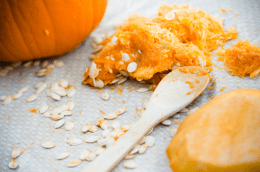Where food safety is concerned, a food thermometer is a must-have, multi-use tool in the kitchen.
tool in the kitchen.
It is one of the most important tools consumers can use to know when food is cooked properly for safe consumption. It’s useful for meat items, casseroles and even baked goods. Using a subjective method – such as ground meat color – can be misleading and lead to foodborne illness. It can help with assuring the quality of a food item and reduce over-cooking.
For consumers who need to buy a food thermometer, the digital type is recommended. Digital food thermometers read the temperature at the tip of the temperature probe. They also read temperature quickly, and come in a simple handheld design.
Consumers who already own a food thermometer can calibrate them routinely to make sure they are still giving accurate readings. The best method is to calibrate your thermometer using ice water and boiling water to check cold and hot readings. Dial faced thermometers can be adjusted if needed. Digital thermometers should be replaced unless it came with instructions on how to adjust.
Along with food thermometers, place an appliance thermometer inside your refrigerator and freezer to monitor temperatures in those appliances. These can be helpful during a power outage to determine the safety of your food. Another suggestion is an oven thermometer to know if your oven is heating properly.
By: Brenda Langdon

 planning and then use that knowledge to plan for next year. One way to assess your progress since January is to compare how much debt you owed at the beginning of the year to now. Do you owe more or less overall? Another is to compare your net worth (assets minus liabilities). Are you worth more now than you were at the first of the year?
planning and then use that knowledge to plan for next year. One way to assess your progress since January is to compare how much debt you owed at the beginning of the year to now. Do you owe more or less overall? Another is to compare your net worth (assets minus liabilities). Are you worth more now than you were at the first of the year?

 Today’s lunch bags are made with a high tech material that kids can use to keep their food cold so they can have a safe lunch when they’re ready to eat it.
Today’s lunch bags are made with a high tech material that kids can use to keep their food cold so they can have a safe lunch when they’re ready to eat it.